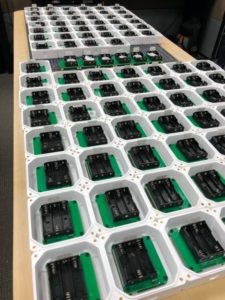Essentium, Inc., a Texas-based original equipment manufacturer (OEM) of additive manufacturing (AM) platforms, announced a recent successful use-case example for the company’s technology by Additive at Scale (AAS), a manufacturing services provider. The latter, also based in Texas, used Essentium’s High Speed Extrusion (HSE) 180 ST printer, along with Essentium’s PCTG-Z filament, to produce 100 asset-tracking pilot units for a chemical manufacturing multinational.

AAS partnered with Blues Wireless, an internet of things (IoT) telecom startup, to print 100 tracking devices for 18-wheeler chassis that transport chemicals. Aside from the low cost and impact strength, AAS selected Essentium’s PCTG-Z material for its electrostatic-discharge (ESD)-safe properties. Materials that are used for cases and housing — like the tracking device housing produced by AAS — are among the consumer goods’ inputs subject to the most stringent ESD-safe requirements.
In a press release, Madison Jones, Additive at Scale’s director, commented, “Having Essentium as a strategic partner has allowed us to tap into the expertise of their material scientists and application engineers to help select the right material and process settings to meet our client’s needs. They also offer the best ESD-safe materials on the market, which in most cases, is ideal for electronic enclosures or assembly of electronics.”

Using the HSE 180 ST platform, as well as Essentium’s support staff, AAS successfully completed the project in just 60 days. Resultantly, AAS has received official vendor status from the chemical manufacturer involved, and, notably, is already starting scale-up of the enclosures’ production.
Last month, 3DPrint.com’s Joris Peels argued convincingly that the success of 3D printed housings should be receiving more attention. This is especially true, given the slow but steady push to make mass-produced, 3D printed microchips a reality, which currently seems to be going on in the 3D printing sector. In order to accelerate that process, continuing to increase the quantity of 3D printed housings in advance would seem to be a prerequisite.
The main problem that 3D printed chips would be addressing first is the seemingly constant lag of supply in the electronics sector, which affects more or less every other major consumer category. This doesn’t solely have to do with lower semiconductor supplies, however, but also with a scarcer supply of feedstocks for plastics. 3D printing chips, alone, then, wouldn’t solve this problem, since there would still be a lag in the supply of housings for electronics.
Thus, making the case for 3D printed chips will be much easier, if 3D printed housings are already ramped up ahead of time. Whether the two things are in fact already related is irrelevant, since it seems like the number of 3D printed housings will continue increasing, regardless. Assuming that happens, it will mean that much of the infrastructure for 3D printing all electronic components aside from chips will already be in place, once the infrastructure for 3D printing the latter exists.
Images courtesy of Essentium
Subscribe to Our Email Newsletter
Stay up-to-date on all the latest news from the 3D printing industry and receive information and offers from third party vendors.
You May Also Like
Printing Money Episode 17: Recent 3D Printing Deals, with Alex Kingsbury
Printing Money is back with Episode 17! Our host, NewCap Partners‘ Danny Piper, is joined by Alex Kingsbury for this episode, so you can prepare yourself for smart coverage laced...
Insights from Cantor Fitzgerald on AM’s Q1 2024 Landscape
A recent survey by Cantor Fitzgerald sheds light on the persistent challenges within the additive manufacturing (AM) industry in the first quarter of 2024. Based on responses from 38 industry...
3D Printing Financials: Xometry’s Scaling up and Strong Start to 2024
Xometry (Nasdaq: XMTR) kicked off 2024 with strong results, boosting its marketplace and technology to new heights. Both revenue and gross margin soared, fueled by an expanding global network of...
3D Printing Financials: Desktop Metal Targets Recovery Amid Net Losses and Revenue Downturn
Despite facing a decline in revenue and the persistent challenges of a tight economic climate, Desktop Metal (NYSE: DM) is making strides toward operational efficiency. The first quarter of 2024...
































